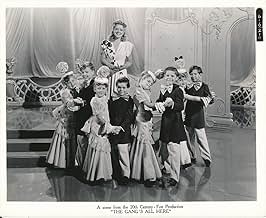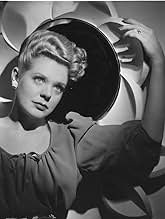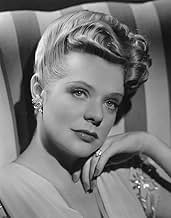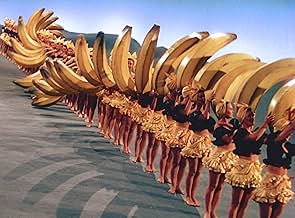CALIFICACIÓN DE IMDb
6.6/10
2.2 k
TU CALIFICACIÓN
Agrega una trama en tu idiomaA soldier falls for a chorus girl and then experiences trouble when he is posted to the Pacific.A soldier falls for a chorus girl and then experiences trouble when he is posted to the Pacific.A soldier falls for a chorus girl and then experiences trouble when he is posted to the Pacific.
- Dirección
- Guionistas
- Elenco
- Nominado a 1 premio Óscar
- 2 premios ganados y 1 nominación en total
Benny Goodman and His Orchestra
- Benny Goodman's Orchestra
- (as Benny Goodman Orchestra)
Don Anderson
- Club New Yorker Patron
- (sin créditos)
Leon Belasco
- Waiter
- (sin créditos)
Brooks Benedict
- Club New Yorker Patron
- (sin créditos)
Lee Bennett
- Club New Yorker Patron
- (sin créditos)
William A. Boardway
- Club New Yorker Patron
- (sin créditos)
Opiniones destacadas
I'll get to the plot of "The Gang's All Here" in a minute, because the plot isn't the most memorable part of this movie. The most memorable part is the bananas.
About 20 minutes into the movie, a towering hat of Technicolor fruit appears on the screen, followed by its owner--'40s "Brazilian bombshell" Carmen Miranda. She proceeds to do a number called "The Lady in the Tutti-Frutti Hat," accompanied by chorus girls who bear bananas. Six-foot-tall bananas that continuously droop and sprout until number's end, when the chorus girls, worn out by the burden of this mutated fruit, lay down for a long siesta on a stage dressed up like an island.
There's a reason this number occurs so early on: It takes you the rest of the movie to convince yourself you actually saw this in a 1943 movie.
But then, this is Busby Berkeley, a director who staged his musical numbers as though he was declaring war. And next to kitsch, war is pretty much the motivator here.
The wafer-thin story involves Andy (James Ellison), a soldier who woos and wins Edie (Alice Faye), a canteen dancer, the night before Andy goes off to World War Two. In what seems an instant, Andy gets decorated and returned home to a victory party thrown by the family of Andy's childhood sweetheart and fiancee--who, unfortunately for Edie, is not Edie.
Will the heartbreak be resolved? Do you really care? The plot is mostly an excuse for some snappy repartee between major '40s stars (in particular, Eugene Pallette and Edward Everett Horton are hilarious), and the kind of musical numbers that seem to drop out of thin air. (In a couple of scenes, Benny Goodman and his orchestra stroll by and do some songs just for the heck of it.)
"The Gang's All Here" is really a 1943 time capsule, but an eye-popping rouser of one. They don't make 'em like this anymore. They didn't make 'em much like this back then, either. It's not out on video or DVD, so look for its sporadic broadcasts on cable TV.
About 20 minutes into the movie, a towering hat of Technicolor fruit appears on the screen, followed by its owner--'40s "Brazilian bombshell" Carmen Miranda. She proceeds to do a number called "The Lady in the Tutti-Frutti Hat," accompanied by chorus girls who bear bananas. Six-foot-tall bananas that continuously droop and sprout until number's end, when the chorus girls, worn out by the burden of this mutated fruit, lay down for a long siesta on a stage dressed up like an island.
There's a reason this number occurs so early on: It takes you the rest of the movie to convince yourself you actually saw this in a 1943 movie.
But then, this is Busby Berkeley, a director who staged his musical numbers as though he was declaring war. And next to kitsch, war is pretty much the motivator here.
The wafer-thin story involves Andy (James Ellison), a soldier who woos and wins Edie (Alice Faye), a canteen dancer, the night before Andy goes off to World War Two. In what seems an instant, Andy gets decorated and returned home to a victory party thrown by the family of Andy's childhood sweetheart and fiancee--who, unfortunately for Edie, is not Edie.
Will the heartbreak be resolved? Do you really care? The plot is mostly an excuse for some snappy repartee between major '40s stars (in particular, Eugene Pallette and Edward Everett Horton are hilarious), and the kind of musical numbers that seem to drop out of thin air. (In a couple of scenes, Benny Goodman and his orchestra stroll by and do some songs just for the heck of it.)
"The Gang's All Here" is really a 1943 time capsule, but an eye-popping rouser of one. They don't make 'em like this anymore. They didn't make 'em much like this back then, either. It's not out on video or DVD, so look for its sporadic broadcasts on cable TV.
It was called "The Girls He Left Behind", when first released in Britain in 1944. In this movie I think Busby Berkeley reached the pinnacle. It was his finest effort. Carmen Miranda, wearing that tutti frutty hat was a mouth-watering revelation; along with her ability to murder the English language. Roly poly Eugene Palette, trying to get the worrisome Edward Everett Horton's mind off his wife. Handing their hats to the hat-check girl, who was the lovely June Haver. (If you blinked you would have missed her). Alice Faye? A dream in Technicolour. James Ellison in the leading romantic role. Where was John Payne? He was the usual romantic lead in these Twentieth Century Fox musical capers of the early nineteen-forties.
Weak plot? Who the hell really cared! The Benny Goodman Orchestra; those songs, and the rich Technicolour, plus the Lanky Charlotte Greenwood, blindly reaching for the telephone and answering with the cat instead, brightened this teen-aged English boy's life in those wartime years of long ago. I have watched it on television more than once. The big question though. Why oh why, has it not been released on video or, better still, DVD? Can anyone explain?
Weak plot? Who the hell really cared! The Benny Goodman Orchestra; those songs, and the rich Technicolour, plus the Lanky Charlotte Greenwood, blindly reaching for the telephone and answering with the cat instead, brightened this teen-aged English boy's life in those wartime years of long ago. I have watched it on television more than once. The big question though. Why oh why, has it not been released on video or, better still, DVD? Can anyone explain?
"The Gang's All Here" is just pure entertainment in the old-school musical style (before Oklahoma!). There's essentially no plot, and what story there is, is full of plot-holes. It's propaganda dressed up in a musical. Don't get negative about this; music and dancing predominate and, of course, the cause is good. Made during WWII it almost subliminally reinforces home front practices during wartime, such as buying war bonds, and staying true to your man in uniform. A lot of this is probably lost to most viewers fifty years later. But think about it, and remember that when this movie was made, the Allied victory was not a sure thing.
And what about the music and dancing? Carmen Miranda in her tutti-frutti hat. Benny Goodman's swing band. Alice Faye. Busby Berkeley. If these people mean any thing to you, they are here in fine form.
And what about the music and dancing? Carmen Miranda in her tutti-frutti hat. Benny Goodman's swing band. Alice Faye. Busby Berkeley. If these people mean any thing to you, they are here in fine form.
No doubt about it, the movie's a cast of characters collected in someone's goofy heaven—Carmen Miranda, Busby Berkeley, and Edward Everett Horton, all together in one padded cell. Throw in leggy Charlotte Greenwood and froggy Eugene Palette, and there's enough colorful types for ten musicals. Aside from the conventional plot, this 1943 trip to bizzaroland doesn't disappoint for sheer wackiness.
Of course, there's Miranda's infamous arching bananas replete with the recumbent girls, all of which could have sent Dr. Freud into terminal overload. Really, how the carnally obsessed Berkeley managed to stay this side of the censor is still puzzling. And catch that final number with the disembodied heads and Palette croaking out a song. I'm just wondering what Berkeley's dreams were like. They couldn't be any weirder than what's there on the screen.
Then there's the top of Miranda's head sporting more pointy architecture than the Manhattan skyline. And catch her wardrobe—somewhere there's a dozen circus clowns without their costumes. After that, add a few lines of her hilariously fractured English, and she's a whole wonderful show in herself. Too bad her personal life was apparently so unhappy.
Great color photography, along with a soulful Alice Faye. Even the pretty much unknown James Ellison seems a good stand-in for the boys in uniform. No doubt about it, Hollywood knew how to concoct lively and engaging wartime shows. But just as importantly, these concoctions still entertain decades later, even with an inspired lunatic like Busby Berkeley in charge.
Of course, there's Miranda's infamous arching bananas replete with the recumbent girls, all of which could have sent Dr. Freud into terminal overload. Really, how the carnally obsessed Berkeley managed to stay this side of the censor is still puzzling. And catch that final number with the disembodied heads and Palette croaking out a song. I'm just wondering what Berkeley's dreams were like. They couldn't be any weirder than what's there on the screen.
Then there's the top of Miranda's head sporting more pointy architecture than the Manhattan skyline. And catch her wardrobe—somewhere there's a dozen circus clowns without their costumes. After that, add a few lines of her hilariously fractured English, and she's a whole wonderful show in herself. Too bad her personal life was apparently so unhappy.
Great color photography, along with a soulful Alice Faye. Even the pretty much unknown James Ellison seems a good stand-in for the boys in uniform. No doubt about it, Hollywood knew how to concoct lively and engaging wartime shows. But just as importantly, these concoctions still entertain decades later, even with an inspired lunatic like Busby Berkeley in charge.
Some of ALICE FAYE's close-ups in THE GANG'S ALL HERE convince me that Technicolor was made to show off the charms of certain actresses--as Fox well knew with such beauties as Betty Grable and Linda Darnell under contract. Faye's blue eyes get all misty-eyed when she sings a ballad--and when she's supported by someone like CARMEN MIRANDA for colorful contrast, well--you can bet it's a musical worth seeing and hearing.
In this case--mostly worth seeing because of Busby Berkeley's magical treatment of all the musical numbers. Who can ever forget CARMEN MIRANDA and all those waving bananas??? Or the kaleidoscope effect of several top numbers in an imaginative use of color and camera effects, the kind that only Berkeley was a master of.
The flimsy plot is strictly by the numbers and practically non-existent in a boy meets girl, boy loses girl, boy wins girl sort of way. JAMES ELLISON is a poor substitute for Fox's contract player John Payne, who must have been busy on another assignment when the cast was assembled. And PHIL BAKER is totally wasted.
But it's not too much of a distraction when the gaudy splashes of color, music and just downright fun provided by Faye, Miranda, Eugene Palette, Edward Everett Horton and Charlotte Greenwood come to the fore.
This is typical Fox escapism made for entertainment during World War II when the troops were all salivating over the Fox pin-up girls. Alice Faye is at her most attractive with her warm contralto voice showcased in a couple of hokey ballads and when she gazes heavenly toward some unseen spirit she practically melts the camera lens. She's luscious and so is the film.
And if you're a CARMEN MIRANDA fan, you can't afford to miss this one. Her "Tutti Frutti" number is a knockout and Benny Goodman and his band provide solid musical back-up. Just don't expect reality to butt in at any point during the silly plot.
Trivia note: That's ADELE JERGENS in the background of girls.
In this case--mostly worth seeing because of Busby Berkeley's magical treatment of all the musical numbers. Who can ever forget CARMEN MIRANDA and all those waving bananas??? Or the kaleidoscope effect of several top numbers in an imaginative use of color and camera effects, the kind that only Berkeley was a master of.
The flimsy plot is strictly by the numbers and practically non-existent in a boy meets girl, boy loses girl, boy wins girl sort of way. JAMES ELLISON is a poor substitute for Fox's contract player John Payne, who must have been busy on another assignment when the cast was assembled. And PHIL BAKER is totally wasted.
But it's not too much of a distraction when the gaudy splashes of color, music and just downright fun provided by Faye, Miranda, Eugene Palette, Edward Everett Horton and Charlotte Greenwood come to the fore.
This is typical Fox escapism made for entertainment during World War II when the troops were all salivating over the Fox pin-up girls. Alice Faye is at her most attractive with her warm contralto voice showcased in a couple of hokey ballads and when she gazes heavenly toward some unseen spirit she practically melts the camera lens. She's luscious and so is the film.
And if you're a CARMEN MIRANDA fan, you can't afford to miss this one. Her "Tutti Frutti" number is a knockout and Benny Goodman and his band provide solid musical back-up. Just don't expect reality to butt in at any point during the silly plot.
Trivia note: That's ADELE JERGENS in the background of girls.
¿Sabías que…?
- TriviaThe production number "The Lady In The Tutti-Frutti Hat" ran into problems with the censors. The Hayes office at first considered the way the gigantic bananas were held in front of the dancers as being too "phallic". The problem was resolved by having the dancers hold the bananas at waist level rather than at hip level.
- ErroresIncorrectly regarded as goof: As the passengers disembark the ship within the first 3 minutes of the film, a series of mechanical-looking large shadows can be easily seen moving across the painted backdrop of buildings intended to be far in the distance. This is actually a stage set of a musical production, thus not filmed as a real scene.
- Citas
Phil Baker: Oh, Dorita, you remember Mr. Potter and Mr. Mason.
Dorita: Ah! I remember Mr. Potty. You are here to kick up some more heels, huh?
Peyton Potter: No!
Phil Baker: Mr. Potter wants you to come to his house this weekend.
Dorita: Ah-ah-ah, you naughty boy. You are what they call a fast-work man, yes?
- ConexionesEdited into Myra Breckinridge (1970)
- Bandas sonorasHail! Hail! The Gang's All Here!
(uncredited)
Music by Theodore Morse and Arthur Sullivan
Lyrics by Dolly Morse (as D.A. Esrom)
Sung by a chorus during the opening credits
Selecciones populares
Inicia sesión para calificar y agrega a la lista de videos para obtener recomendaciones personalizadas
- How long is The Gang's All Here?Con tecnología de Alexa
Detalles
- Fecha de lanzamiento
- País de origen
- Idiomas
- También se conoce como
- The Gang's All Here
- Locaciones de filmación
- Productora
- Ver más créditos de la compañía en IMDbPro
- Tiempo de ejecución1 hora 43 minutos
- Color
- Relación de aspecto
- 1.33 : 1
Contribuir a esta página
Sugiere una edición o agrega el contenido que falta

Principales brechas de datos
By what name was Entre la rubia y la morena (1943) officially released in India in English?
Responda





































